It is located in the town of Al-Bahariyah, about 5 km from the Al-Nashabiyah subdistrict to the northeast, and approximately 20 km east of Damascus. It is a large hill covering an area of around 25 hectares, bisected by a paved road running north toward Mid‘a and Adra. The site contains several elevated areas, the highest of which is in the northern section and rises no more than 10 meters above the surrounding lands, which consist of fertile agricultural plains.
Excavations at the site began in 1996 by a national mission that included students from the Intermediate Institute of Archaeology and Museums. The mission was headed by Ghada Suleiman and included participants Zuhair Muhammad and Noha Qabbani. The excavations revealed settlements dating back to the end of the Neolithic and the beginning of the Chalcolithic periods (circa 6000–5200 BCE). The site was also inhabited during the Chalcolithic period, as evidenced by several archaeological layers dating from 5200 to 3500 BCE.
Additionally, throughout Al-Bahariyah and its agricultural lands—especially in the southern areas—numerous archaeological remains from the Roman and Byzantine periods can be found, including remnants of walls, columns, capitals, cornices, basins, stone coffins, pottery shards, and more. These indicate the prosperity and significant development the town experienced during these periods.
However, the most important phase for Al-Bahariyah, as we believe, was during the second half of the 4th millennium BCE, when it was one of the key sites witnessing humanity’s transition from prehistoric to historical periods in southern Syria and the Levant—a stage often referred to as the dawn of history. This is evidenced by many of the site’s finds, which have not yet received the attention they deserve. Consequently, the hill has not been thoroughly researched or studied, largely due to the archaeological authorities’ limited interest in the mission, since it was an educational excavation. We hope this will be addressed in the near future.
The earliest settlement phase, dating to the 6th millennium BCE, included circular houses and regular rectangular houses with mudbrick walls. Numerous graves were also uncovered, containing human skeletons buried in various positions, including crouched or fetal postures. In some burials, a clay mass shaped like a pillow was placed under the head, while in others a layer of clay was laid beneath the body as a sort of bedding. The graves were covered with broken pottery shards.
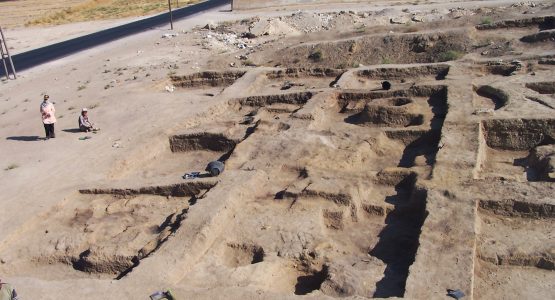
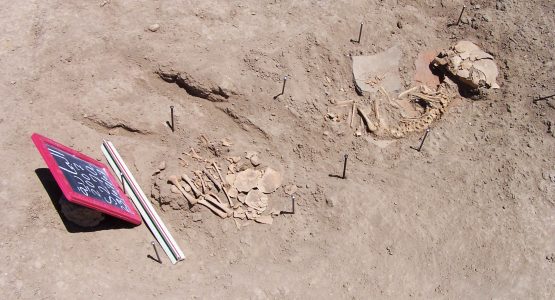
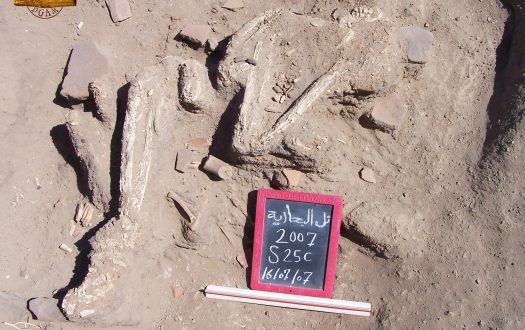
Human skulls separated from the bodies were also found beneath the floors of houses, indicating the presence of ancestor worship. Sometimes these skulls were carefully buried in circular pits surrounded by pottery shards or stones. Animal skulls were also discovered, similarly buried with pottery fragments; one child’s grave was accompanied by a goat horn. Several graves contained artifacts such as flint blades, occasionally placed on the head, as well as pottery, clay balls, clay beads, and crafted stones shaped like crescents with engraved designs.
From this period also comes a collection of female clay figurines representing the Mother Goddess. Some of these figurines were headless, made of baked clay, and sometimes decorated to indicate clothing, though breasts were depicted. Some figurines had decorations on the head, with eyes attached in a “coffee bean” shape. Stone female figurines were also found, showing pronounced bellies, symbolizing fertility. Animal figurines representing goats, bulls, pigs, birds, and others were also discovered, dating to the first half of the 6th millennium BCE.
In the layers dating to the Chalcolithic period, beginning around 5200 BCE, architectural remains were found, some in a ruined state, including square and rectangular rooms, sometimes containing hearths, ovens, and pits for grain storage. Walls were built of large molded mudbricks (40 × 60 cm), while some square rooms had floors coated with a layer of lime, and rectangular rooms had floors paved with smaller bricks. Storage rooms for grains and provisions were also uncovered.
Another layer revealed mudbrick walls, pottery-making ovens, and platforms for placing prepared pottery. Burials occurred alongside the walls of some rooms, with bodies in fetal positions, accompanied by flint tools, clay balls, and pottery fragments. The practice of burying animal skulls beneath house floors continued, including wild boar skulls.
In a later layer, dating to the 4th millennium BCE, burial practices persisted in the same manner: beneath house floors, near walls, in fetal positions, with pottery accompanying the deceased. Children began to be buried in fetal positions inside elongated pottery jars with wide mouths, placed one meter or more below ground. Graves continued to be covered with fragments of pottery jars and accompanied by pottery vessels and small containers (one small jar was filled with charred grains), as well as jewelry such as necklaces made of white and black beads crafted from bone and stone. Animals continued to be buried alongside humans.
The latest archaeological layers at the site date to the Uruk period (Chalcolithic). Significant architecture was uncovered on the northern high point of the hill: a massive building with wide walls made of large red and brown mudbricks, likely a public structure, probably a temple, pending further excavation. Ordinary mudbrick houses were also found. Most importantly, numerous distinctive artifacts were uncovered, including human and animal figurines, especially bird heads, as well as tablets with perforated impressions used for counting and calculations. Clay balls and pebbles believed to have been used for counting were also found. These represent civilizational innovations that paved the way for the emergence of writing, marking the end of prehistory and the beginning of early historical periods.
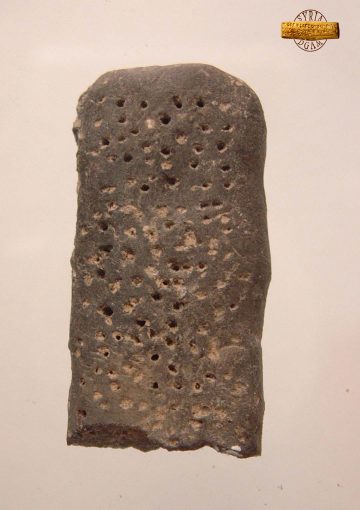
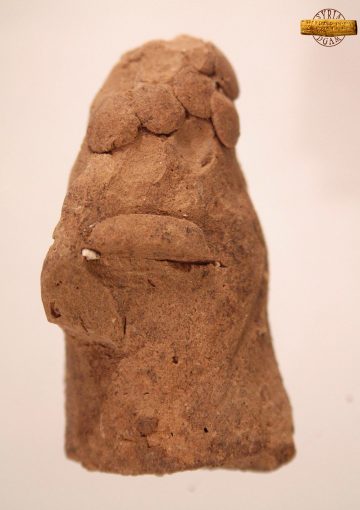
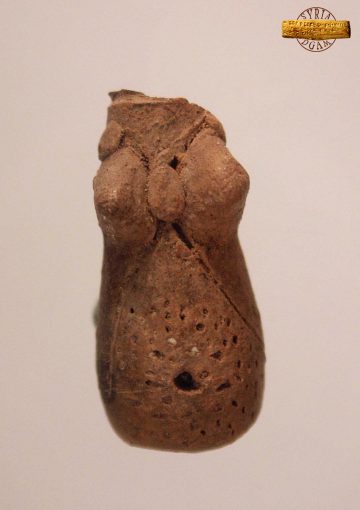
Some of the artifacts, including the bell-shaped pottery vessels found on the hill, indicate the importance of the site during this period. They resemble Uruk-period sites in Mesopotamia and have also been found at several Syrian sites, including Tell Hamoukar in the Jazira region, Tell Habuba, and Tell Qanas on the middle Euphrates, among others.
The pottery of Al-Bahariyya, dating to the 5th millennium BCE, was distinguished by its quality and colors—black, red, and orange. It was well-polished and sometimes decorated with patterns such as braids or incised circles on the surface of the vessels. Thin, polished pottery vessels colored in black, orange, and red with decorative bands were also discovered. Of particular importance is the discovery of pottery fragments from the Tell Halaf culture at the site. Although rare, these fragments provide evidence that northern influences reached this site, which may have represented the southernmost extent of their presence in Syria.
For this reason, we believe that the Al-Bahariyya site will be one of the locations most likely to yield significant archaeological results in the coming period, provided it receives the necessary resources and scientific expertise.




